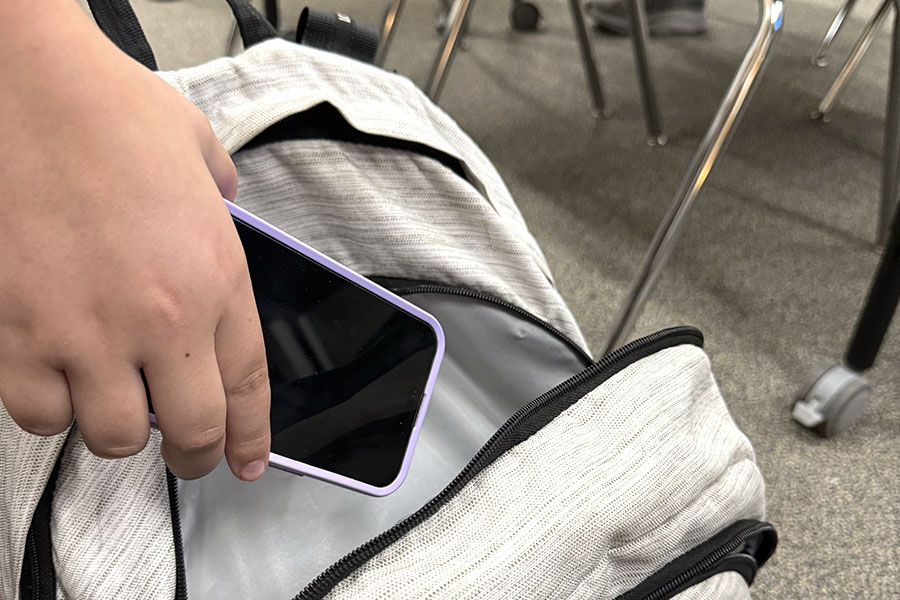Her dark room is finally quiet as she starts to fall asleep. She can hear the flutter of her posters on her walls from the fan rapidly blowing air. She can hear her clock downstairs in the kitchen ticking away. She can hear her breathing slow as she slips into unconsciousness. All of a sudden, as her mind begins to unfold into pale colors and dreamy bliss, she’s jolted awake from a piercing siren. Frantically, she bolts upright, looks around and breathes a sigh of dread as she realizes that her “baby” needs to be fed again.
The RealCare baby is an infant simulator used for projects and classes such as the baby care project in the Human Growth and Development class. Students get to sign up for a weekend to take this simulation home and tend to its needs like an actual baby.
“I thought it was going to be really easy because I thought that it didn’t take that long to do [tend to needs],” junior Elia Reed said. “[I thought] it would cry and I would quickly do it [take care of it] and then it would sleep.”
Because the simulation mimics a real baby’s needs, it requires students to be up at night when the baby needs to be tended to.
“Waking up was the worst part,” Reed said. “I was awake from 2 am to 4 am and I had to wake up again at 6 am. Everything else was honestly manageable, it’s just how much it cried at night.”
Some of the needs that the babies cry for are feeding, burping, rocking and diaper changing. Because the babies are on different care schedules, this project’s overall difficulty varied for some people.
“It was a lot more than I was expecting,” junior Charlie Lehman said. “It was stressful and the baby was really loud and it needed constant attention.”
For junior Cheyanne Avery, this project was not as hard for her as it was for other students.
“Caring for the baby [I] didn’t really have to do much,” Avery said. “[I] just kept it in the carrier, rocked it in the carrier, and burped it in the carrier.”
Because it’s turned on all weekend, the baby can cry at any point and time. According to students, doing this project can be stressful and inconvenient.
“It’s such a hard assignment and it’s so exhausting having to do it,” Reed said. “You have to be up all night, you have to constantly stop what you are doing to take care of the baby, you have to completely pull over if the baby starts crying. It’s annoying and it’s just not fun.”
There are some mixed feelings about how accurate this project really is compared to taking care of an actual baby
“I think part of it was accurate but some of it was over exaggerated and some of it was under exaggerated,” junior Cheyanne Avery said. “You would never feed a baby for 40 minutes straight, you don’t have to rock it [for 40 minutes], and you don’t have to scan an ID.”
For Lehman, doing this project meant that she didn’t have a lot of alone time.
“I liked having a constant companion with me,” Lehman said. “I was never alone for more than two seconds because it was really loud and needed constant attention.”
In addition to learning how to care for a real baby, there are also some positive aspects to this project according to Reed.
“Everywhere [I went] people would ask [me] about it and talk to [me],” Reed said. “It’s a good conversation starter. There would be multiple times where fast food workers would talk to me about the fact that there’s a baby in the passenger seat, and it was really just something cool to talk about.”



![Jumping off the ground, senior linebacker Bennett Patton snatches the ball out of the air for an interception at Thursday’s game against Chaparral. Patton had two interceptions in the 56-14 victory, tying the school record for interceptions in a game. “I was just playing the game,” Patton said. “[I’m] going to go into next week, forget about it and stay humble.” Photo by Harper Chapman](https://cphswolfpack.com/wp-content/uploads/2025/09/bennett-interception.jpg)
![The fire department came to the school after students were evacuated when smoke started coming from the ceiling of a classroom. All students and staff are safe. “All of my friends left their stuff too, so we couldn’t contact our parents, and it was stressful,” senior Brynn Fowler said. “It was scary because I didn’t know [what was going on], and I couldn’t find anyone because it was a big crowd.” Photo by Anthony Garcia](https://cphswolfpack.com/wp-content/uploads/2025/09/firetruck.jpg)


![Sitting with her friend senior Sohpia Struve at last year’s Austin City Limits Festival, senior Ava Zuniga poses for a picture under a pavilion. They are frequent attendees at ACL, an annual music festival at Zilker Park. “I would recommend seeing a bunch of people,” Zuniga said. “This past year, we camped out for Chappell [Roan] for a really long time. I think the whole point of ACL, [which] is a lot of fun, is that you can go see so many different people, even if you don’t know them. So by camping by one person, it really limits yourself from being able to go see a bunch of people.” Photo courtesy of Ava Zuniga](https://cphswolfpack.com/wp-content/uploads/2025/10/EE9E9484-FE6F-4AA0-B5F5-0C177AB32841-1200x857.jpeg)
![Broadcast, yearbook and newspaper combined for 66 Interscholastic League Press Conference awards this year. Yearbook won 43, newspaper won 14 and broadcast took home nine. “I think [the ILPC awards] are a great way to give the kids some acknowledgement for all of their hard work,” newspaper and yearbook adviser Paige Hert said. “They typically spend the year covering everyone else’s big moments, so it’s really cool for them to be celebrated so many times and in so many different ways.”](https://cphswolfpack.com/wp-content/uploads/2025/05/edited-ILPC.jpg)





![Looking down at his racket, junior Hasun Nguyen hits the green tennis ball. Hasun has played tennis since he was 9 years old, and he is on the varsity team. "I feel like it’s not really appreciated in America as much, but [tennis] is a really competitive and mentally challenging sport,” Nguyen said. “I’m really level-headed and can keep my cool during a match, and that helps me play a bit better under pressure.” Photo by Kyra Cox](https://cphswolfpack.com/wp-content/uploads/2025/09/hasun.jpg)

![Bringing her arm over her head and taking a quick breath, junior Lauren Lucas swims the final laps of the 500 freestyle at the regionals swimming competition on date. Lucas broke the school’s 18-year-old record for the 500 freestyle at regionals and again at state with a time of 4:58.63. “I’d had my eye on that 500 record since my freshman year, so I was really excited to see if I could get it at regionals or districts,” Lucas said. “ State is always a really fun experience and medaling for the first time was really great. It was a very very tight race, [so] I was a bit surprised [that I medaled]. [There were] a lot of fast girls at the meet in general, [and] it was like a dogfight back and forth, back and forth.” Photo by Kaydence Wilkinson](https://cphswolfpack.com/wp-content/uploads/2025/03/Kaydence-2.7-23-edit-2.jpg)
![As the support team sits and poses for a photo in the cafeteria with the counseling team they eagerly wait to start their day. "We [all] seem to be a team, I get up every day and there's days where I don't want to go to work today, but I'm thankful that I have a job and I'm blessed to have what I have," Christopherson said. Photo Courtesy of Julie Weltens.](https://cphswolfpack.com/wp-content/uploads/2025/01/AF9E8470-10D7-4C91-BF28-EC8F86BAB66C-1200x852.jpeg)
![As he sprints with the ball, senior running back Trae Hill breaks a tackle during Friday’s 35-14 loss against the Vandegrift Vipers. Hill ran for 135 yards and two touchdowns during the game. “[Scoring] was electric,” Hill said. “It always feels good to score, but the O-line did everything.”](https://cphswolfpack.com/wp-content/uploads/2025/09/IMG_0795allie.varfb_-1200x799.jpg)















